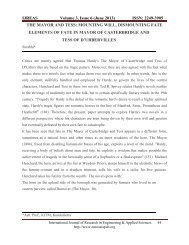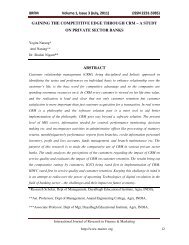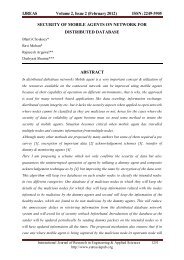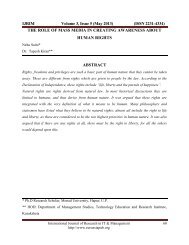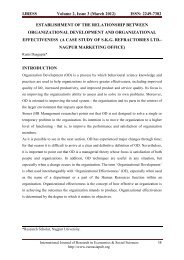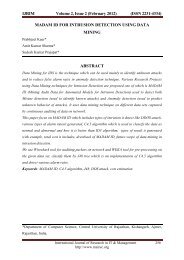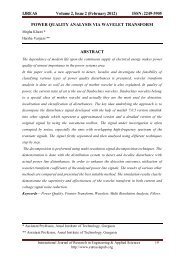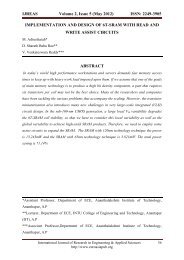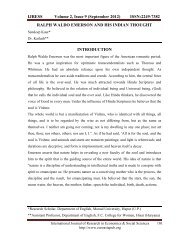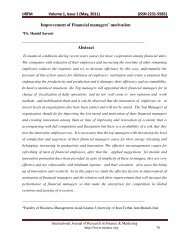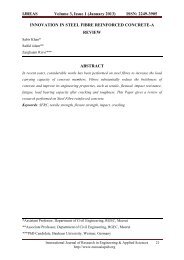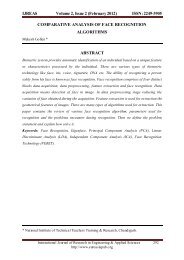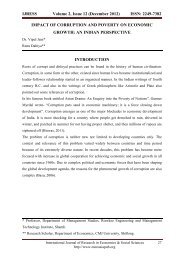scope of biodiesel in india - Euroasiapub.org
scope of biodiesel in india - Euroasiapub.org
scope of biodiesel in india - Euroasiapub.org
You also want an ePaper? Increase the reach of your titles
YUMPU automatically turns print PDFs into web optimized ePapers that Google loves.
IJREAS Volume 2, Issue 8 (August 2012) ISSN: 2249-3905<br />
INTRODUCTION<br />
This study identifies no less than 13 different ways <strong>of</strong> <strong>org</strong>aniz<strong>in</strong>g the value cha<strong>in</strong>, rang<strong>in</strong>g<br />
from cultivation on large plantations to contract farm<strong>in</strong>g arrangements, farm-based<br />
production for rural electrification, and social forestry projects. Between these different types<br />
<strong>of</strong> value cha<strong>in</strong>s, there are marked differences <strong>in</strong> terms <strong>of</strong> <strong>in</strong>come generation, participation and<br />
empowerment, food security, natural resources management and climate change, and<br />
economic susta<strong>in</strong>ability.<br />
BIODIESEL IN THE GLOBAL CONTEXT<br />
From 1971 to 2005, the world’s f<strong>in</strong>al consumption <strong>of</strong> oil rose from about 2000 million<br />
tonnes/year to almost 3500 million tonnes/year. correspond<strong>in</strong>gly, the price for crude oil on<br />
the world market went up from 20 US$/barrel <strong>in</strong> the 1990s to over 145 US$/barrel <strong>in</strong> July<br />
2008. Although prices fell below 100 US$/barrel aga<strong>in</strong> <strong>in</strong> October, when this study was<br />
f<strong>in</strong>alized, most analysts expect higher oil prices <strong>in</strong> the long term. In view <strong>of</strong> ris<strong>in</strong>g prices and<br />
the environmental – and primarily climate-change – concerns that result from <strong>in</strong>creased<br />
global energy consumption, countries all over the world have launched bi<strong>of</strong>uel programmes<br />
to develop alternatives to conventional fuels. While the share <strong>of</strong> bi<strong>of</strong>uels <strong>in</strong> overall global<br />
fuel consumption was still marg<strong>in</strong>al <strong>in</strong> 2006 (less than 1 %), the growth rate <strong>of</strong> bi<strong>of</strong>uel<br />
production is enormous. Between 2000 and 2005, worldwide production <strong>of</strong> bioethanol rose<br />
by 95 % and <strong>biodiesel</strong> output even grew by 295 %. 1 Bioethanol and <strong>biodiesel</strong> need to be<br />
dist<strong>in</strong>guished when we speak <strong>of</strong> liquid bi<strong>of</strong>uels.2 Bioethanol is derived from starch and sugar,<br />
mak<strong>in</strong>g maize and sugar cane – or the waste products produced dur<strong>in</strong>g their process<strong>in</strong>g – the<br />
most important feedstock used for its production. In contrast, <strong>biodiesel</strong> is obta<strong>in</strong>ed from any<br />
k<strong>in</strong>d <strong>of</strong> vegetable oil like rapeseed, soybean, palm or sunflower oil, for example. With 28.3<br />
billion litres, global production <strong>of</strong> ethanol is about six times as high as <strong>biodiesel</strong> production<br />
and therefore more relevant on the global scale. Demand for bi<strong>of</strong>uel is ris<strong>in</strong>g especially due to<br />
mandatory blend<strong>in</strong>g requirements adopted by large energy consumer countries. In order to<br />
contribute to energy security and to abide by the requirements <strong>of</strong> the Kyoto protocol, many<br />
have developed ambitious plans to further substitute bi<strong>of</strong>uel for fossil fuel. In 2003, for<br />
example, the EU set targets for blend<strong>in</strong>g bi<strong>of</strong>uel <strong>in</strong> the transport sector at a rate <strong>of</strong> 2 % by<br />
2005 and 5.75 % by 2010. In addition, several European countries support the use <strong>of</strong> bi<strong>of</strong>uels<br />
through tax reductions or higher 1 The driv<strong>in</strong>g countries <strong>in</strong> bioethanol production are ma<strong>in</strong>ly<br />
Brazil and the United States, while especially Germany and France are engaged <strong>in</strong> produc<strong>in</strong>g<br />
<strong>biodiesel</strong>. Germany, with a share <strong>of</strong> about 40 %, is the world’s largest <strong>biodiesel</strong> producer<br />
International Journal <strong>of</strong> Research <strong>in</strong> Eng<strong>in</strong>eer<strong>in</strong>g & Applied Sciences 2<br />
http://www.euroasiapub.<strong>org</strong>



